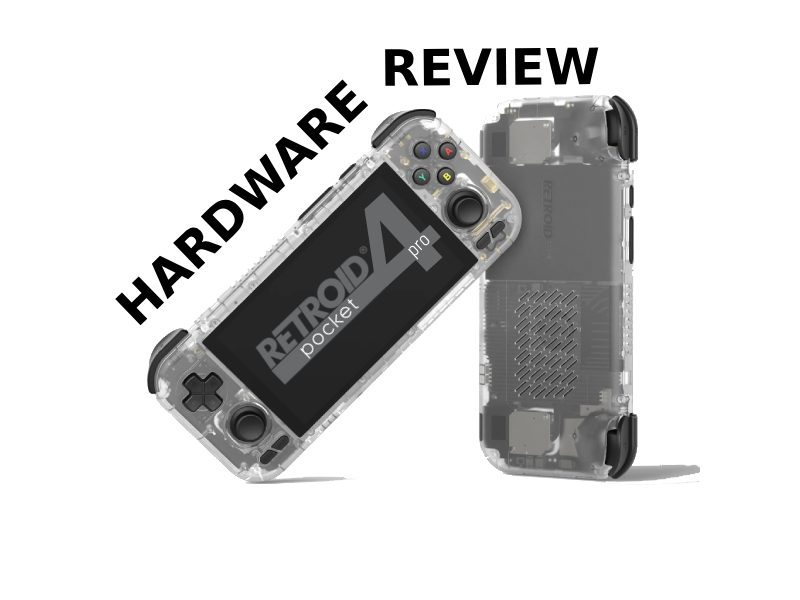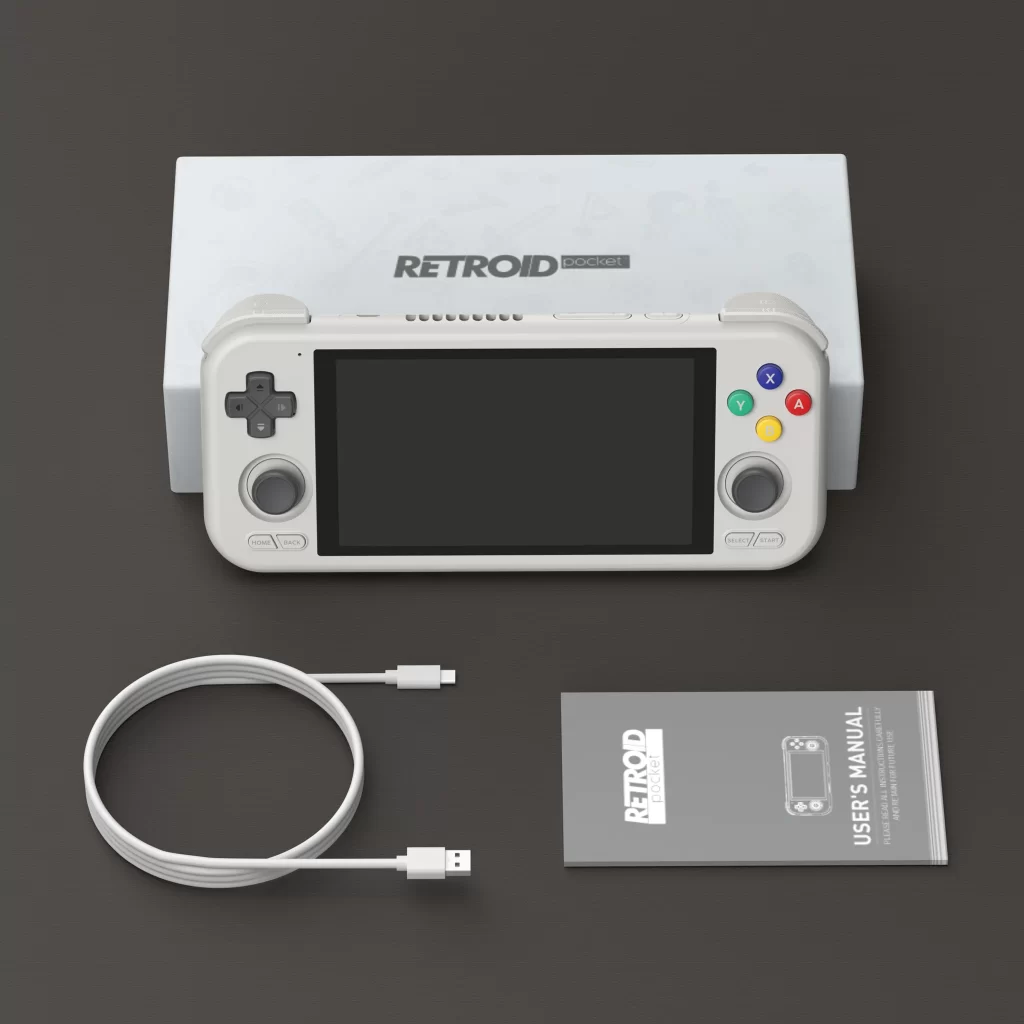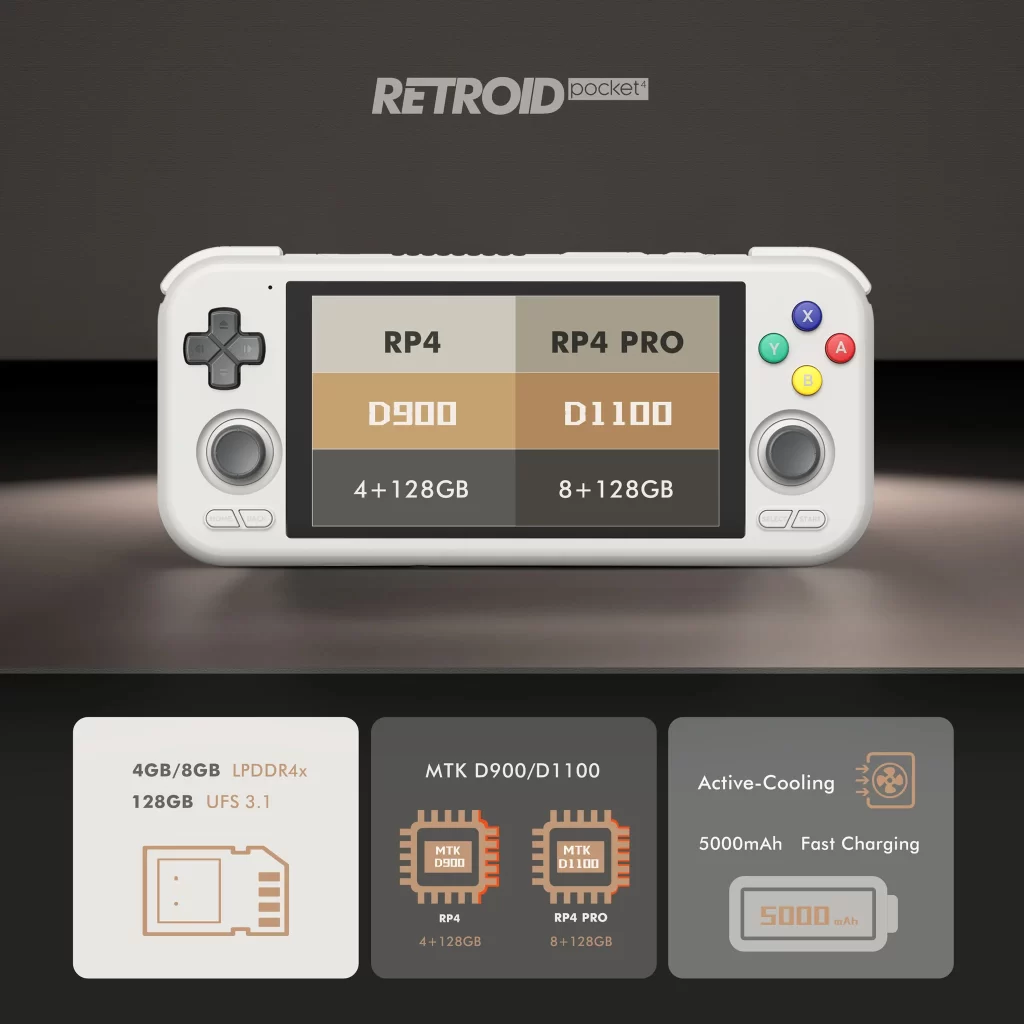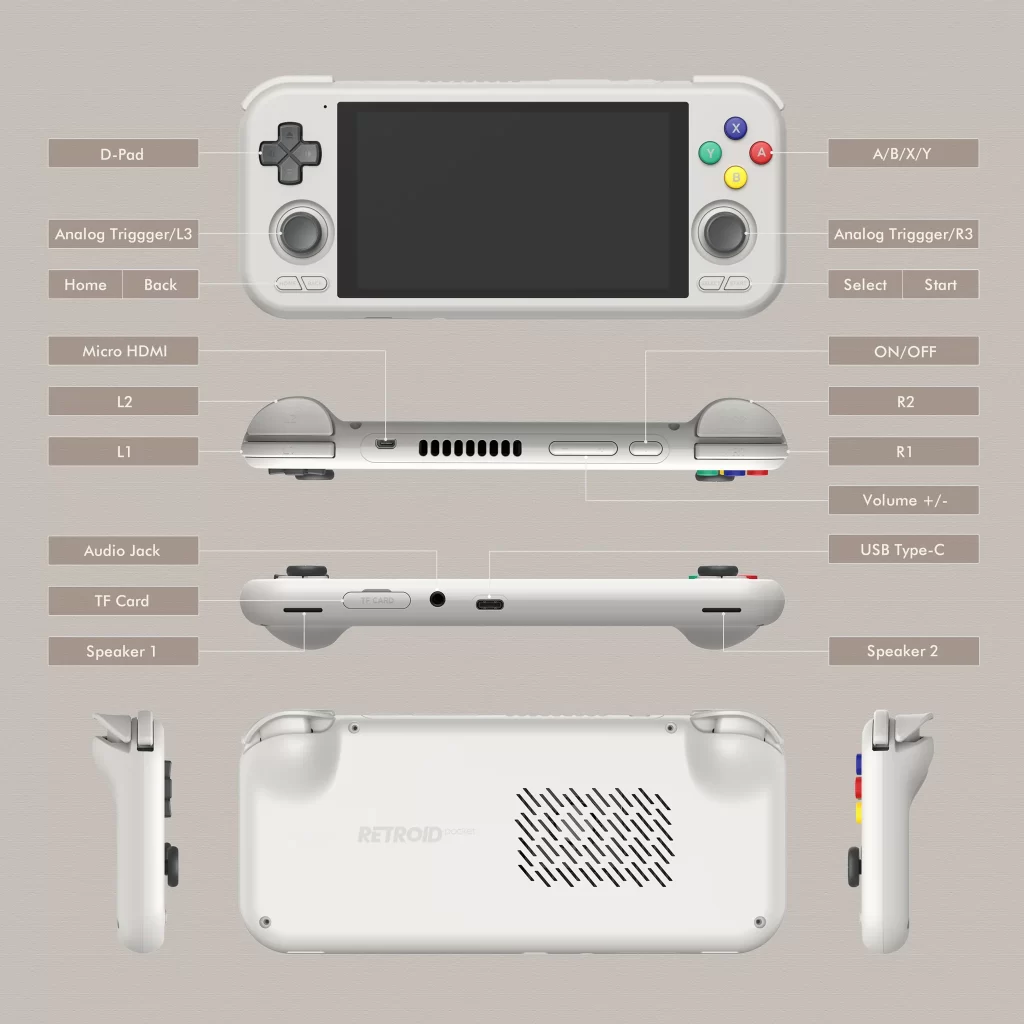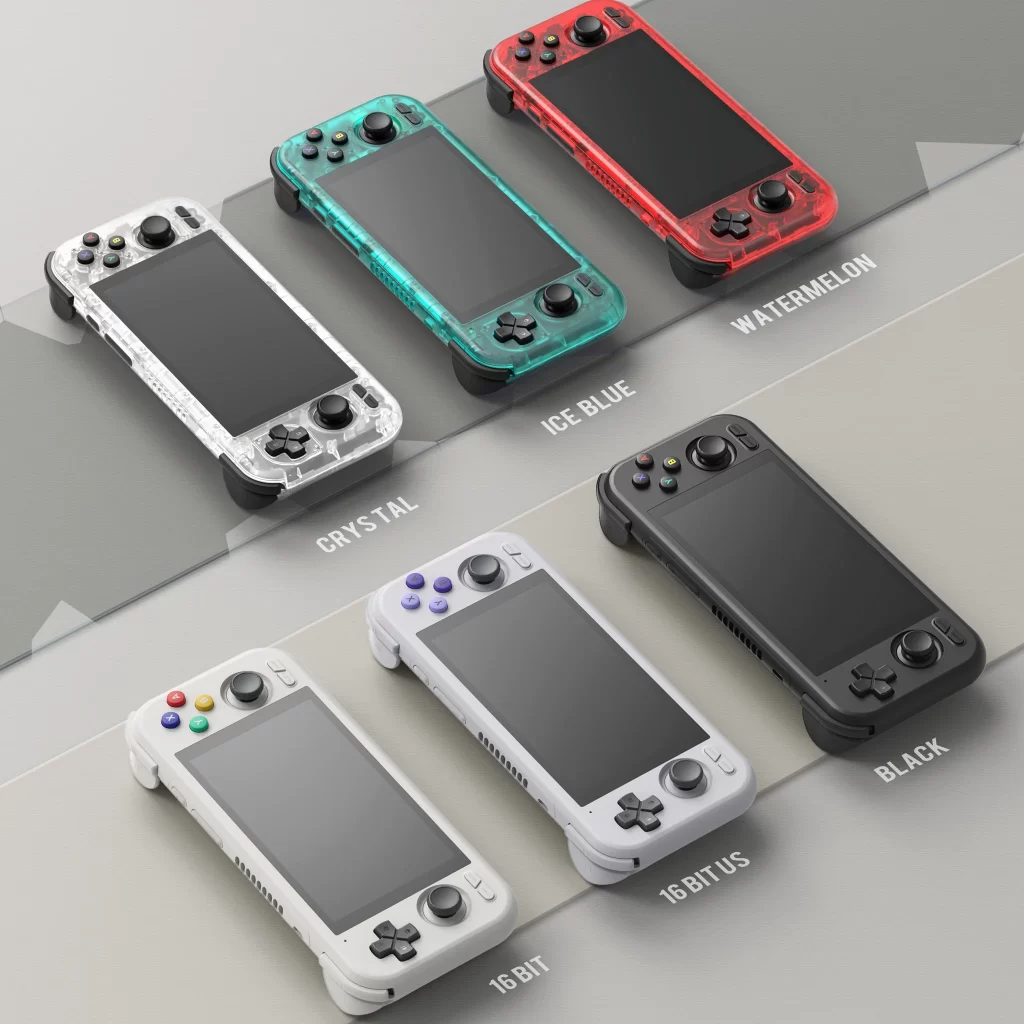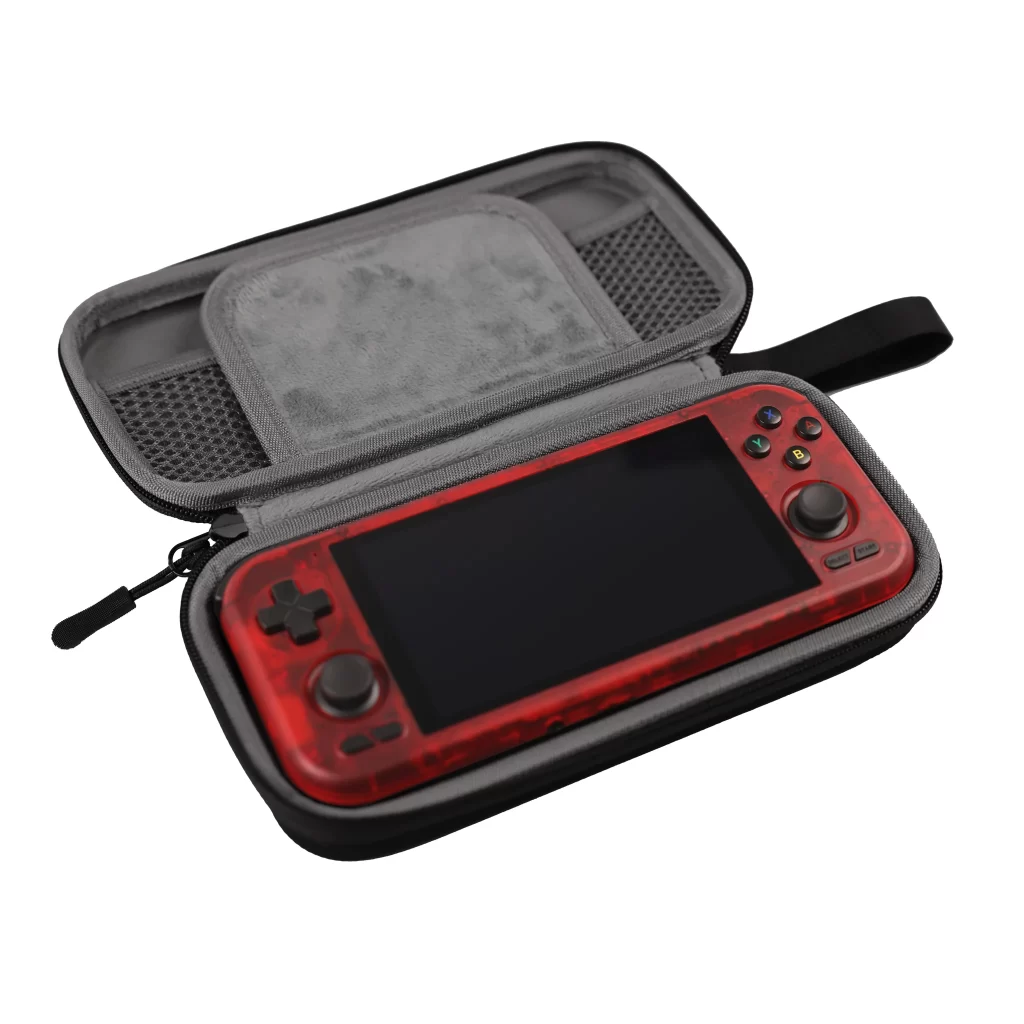This one has been a long time coming. I’ve been trying over the years to get a Retroid device of any kind to review on our site. People hold the products in such high regard and that means something. I wanted to see what all of the fuss was about. So join me as we discuss the fuss and let you in on the secret!
Features:
- CPU: 4*78@2.6GHz 4*A55@2.0 GHz
- GPU: G77 MC9@836MHz
- RAM: 8GB LPDDR4x
- Storage: 128GB UFS 3.1 + TF Card Slot
- OS: Android 13
- Touch screen: 4.7 inch, 750×1334@60fps, 500nits
- Heat Dissipation: Active-cooling
- 5000mAh battery
- Analogue L2/R2
- 3D hall sticks
- BT 5.2&Wi-Fi 6
- Official OTA support for incremental software upgrade
Unboxing & Setup:
Pros:
- Emulation. I want to start by saying that my review is going to be from the stand point of you buying this and using it out of the box. We’re not going to talk about overclocking or importing different emulators than what it already has. We’re talking take it out of the box and add ROMs to the existing device and what kind of experience you get by default (as well as some cores I added from within Retroarch). One more quick point before we jump in, there’s just far too much to cover. If you look up covering what this device can play, there are videos that are an hour or more. I’m going to tell you if the emulators on board are great, good, mid, low, or just plain bad. I tested 10 games on each to get to this point, so I think that’s a good rational marker and I stand by my opinions. The list is below:
- Atari -Great, via Retroarch (using any cores, they all work great)
- NES-Great, via Retroarch (using any cores, they all work great)
- SNES-Great, via Retroarch (using any cores, they all work great)
- N64-Great, via M64 Plus FZ
- Gamecube/Wii-Good, via Dolphin (changing between Vulkan and OpenGL was annoying)
- Sega Master System-Great, via Retroarch (Genesis Plus GX Wide core)
- Sega Genesis-Great, via Retroarch (Genesis Plus GX Wide core)
- Sega 32x & CD-Great, via Retroarch (Genesis Plus GX Wide core)
- Sega Saturn-Good, via Retroarch (changing between beetle and yabause cores was annoying)
- Sega Dreamcast-Good, via Redream (didn’t try Flycast or a Retroarch core[yet])
- PS1-Great, via Duckstation
- PS2-Good (AetherSX2 emulator no longer supported)
- PSP-Great (PPSSPP)
- GB/GBC-Great, via Retroarch (using any cores, they all work great)
- GBA-Great, via Retroarch (using any cores, they all work great)
- DS-Good, via Retroarch (melonDS core)
- 3DS-Mid, via Citra (changing between Citra and Citra Enhanced was annoying)
- Power. The Retroid Pocket 4 Pro lasted an average of 5-7 hours for my average play testing sessions without enabling the battery saver option. Additionally, this device can last days longer in standby mode than the Switch Lite can. And the device itself also doesn’t take long to charge at all. I used the USB-C cord that it came with and an old Roku USB power cube to charge it with. I found that it was fully charged within 3 hours, while not using it. It took about 4 total hours to charge fully while I was playing it. I’m guessing your results may vary depending on what you plug the cord into, but they can at least be as low as 3 hours. You may be asking me what settings I ran the device in to get to that. What a perfect segue to the next section.
- Performance. There are different modes of power and computation and different fan speeds to boot. The different modes that are available to you are “Standard”, “Performance”, and “High Performance.” With regards to the fan modes, there is “Quiet”, “Smart”, and “Sport”. For the purposes of this review, I did not examine the higher performance modes, I just stuck at “Standard” and “Smart” fan setting. I’ve since used them all and it seems that if you put it in “High Performance” you’re going to get “Sport” mode automatically turned on. If you run those higher modes, you’re likely to burn the battery faster since you’re activating more hardware functionality. I will say that if you want to avoid any issues of emulation, especially on the heavier, newer consoles from the N64 and higher, just run in “High Performance” mode to get you over any flukes that may pop up in games running on lower performance modes.
- Navigation. This section may be worthless to some, but I’m hoping that someone finds value in this like I do. I personally love that navigating the Android OS and the Retroid launcher is simple to do. If you want to use the touch screen only, you can do that. If you want to use the D-Pad and face buttons, that is an option. If you want to use the thumbstick and face buttons, you can do that too. If you want to use some combination of these, you can freely do so. I hate with a fiery passion when a system locks you down to only one or the other even if it has both.
- Build Quality. Now if you already watched my unboxing/setup video, you’ll see the whole layout of the device. If you haven’t yet, there is an image below that you can use to reference what I’m about to talk about. I’m not going to discuss that the device has things like a power switch or a volume rocker. Those buttons are obvious in this day and age. They’re on the top of the device, if you’re wondering.
Now what’s not obvious in this day and age, is the dual speakers and the direction in which they fire. Also, it’s not always a given that you’ll get a headphone jack. Both of these items are present on the bottom of the device. That means that the audio is down firing and means that you’re less likely to block the sound. I’m comparing it to ones who put the speakers and the front bottom where your palms typically rest. There’s not much more to say about the audio jack on the bottom, other than it’s neighboring the USB-C port. The USB-C port actually has a couple of different functions. It serves as the method of charging for the Pocket 4 and 4 Pro. Secondarily, it also covers you if you want to do video out to a monitor or TV.
The top of the device, to the left of the volume, is another method of video out. You’ll see a funny little trapezoid looking port, it almost looks like a slender HDMI port…well that’s because it’s the microHDMI port! That’s right, the microHDMI and the USB-C port can both extend video out to a screen and they both do it at 720p. I’m guessing that not many people own a microHDMI, and if that’s the case, USB-C cables are easy to come by!
Of course the D-Pad and face buttons are ever present, so we don’t have to dwell on them too much. I will say that the dome style D-Pad combined with the conductive rubber pads of the face buttons is a match made in heaven. And with regards to the thumbsticks, I still prefer the Switch thumbsticks over these. But that in no way means that these aren’t great, it’s just my personal opinion. These serve the purpose, they’re comfy, and click great as well. I just like the cap of the thumbstick on the Switch better.
I also want to mention that if you’re gung-ho on playing newer dual thumbstick games, it’s not great. It does feel less comfortable than games with a D-Pad for movement, but there is a solution. I recommend to you order an official grip with handles from Retroid. And the last point of the front, there are four buttons that each serve a very different purpose. Not all of them work in every game or work the same in every game. On the far left, there is a Home button that serves as a way to return to the Android OS. To the right of that is the Back button which serves as a method to go back just one screen. On the right side of the screen are the other two buttons, you can probably already guess that they’re Start and Select. These work the same as you’ve ever expected them to work. If an emulated game has a Start and/or Select button, these are what you’ll push for them.
Next we can talk about the triggers and the back of the device. I wanted to focus on these last for a few different reasons. I do believe that they made the right choice on the size of the L2 and R2. They feel great and in the Android OS settings, you can change them between Analog and Digital. But what I found most interesting, and I can’t remember if I showed it in my video, is the texture on the triggers. Which means they took these triggers that already feel great, but they also added a grippy texture on them so you don’t slide off mid-press. And speaking of texture, I do have to say that the fact that the plastic isn’t glossy gives it a better feel and grip. The entirety of it is covered in a matte, deep texture that helps it from slipping out of particularly sweaty hands.
- Emulation Box. One really great feature of this that we just touched on is the ability to get video out on this device. If you’re someone who is looking for a multifaceted device, this is really your time to pounce. Not only is this a fully portable device, but it is more of a Switch than the Switch Lite that it takes inspiration from. Once you’re home for the day, if you want to keep playing your favorite games, you can just hook this up to a USB-C dock or an microHDMI cord and it will show up in 720p on your TV. Best of all, you can then sync up your favorite bluetooth controller (doesn’t matter if it’s retro or modern), and then continue playing once you’ve switch over to the controller setting in the emulator. From DOS to PS2 and even remote play/cloud game more modern systems, including Steam. And let’s not forget that with this device being an Android device and us having the key binding software in the “Floating Icon” menu, you can play any touchscreen Android game you love on a TV. So all in all, this really is such a smart purchase. Video out adds that much more value to the sale.
- Setup. If you watched my unboxing and setup video, you already saw how easy the setup is. I had troubles with it connecting to my 5G wifi at first, so I had to use my standard wifi. After it was all of the way in the Android OS, I was able to get it to connect to 5G. In the setup, you’ll also see that it has preloaded apps that you can choose from for it to populate on the main OS. I enabled everything that it allowed for that was an emulator. Additionally, you can choose if you want to use Android OS as the main menu or the Retroid Launcher. I turned on the Retroid Launcher for simplicity’s sake, since I knew I was reviewing this with a layman perspective. After about 2 minutes, I was in the main menu and ready to add ROMs. We already mentioned the performance and fan modes of the menu. But I do also want to quickly mention the “Floating Icon” option in the drop down settings in the OS. If you enable it, it gives you a menu that you can pop up in games to tweak settings including key bindings. It’s super useful and there’s absolutely no reason not to have it enabled.
- Other Gaming. With regards to gaming on the Retro Pocket 4 Pro, it’s not all about Retro. Sure, it’s in the name and it has emulators baked into it. But there are other experiences present in the experience with more to add. For instance, I got GooglePlay and Amazon App Store loaded up and installed plenty of Android games. But that’s not all! I’ll quickly list the built-in add-ons and discuss what they do.
- Openbor is a 2D, “beat ’em up” game loader (if you will). Popular for retro arcade enthusiats and covers a wide range of games including Double Dragon, Streets of Rage, and Final Fight.
- UnCiv is a strategy game where you build your civilization, research technologies, and fight other players. It is fast, small, free, and moddable, with no ads.
- PojavLauncher is a flexible, fast and open-source Minecraft Java Edition launcher for Android and iOS.
- Serious Sam Android is an ongoing port of Serious Sam: The Second Encounter for Android.
- Easy RPG Player is a program that allows to play games created with RPG Maker 2000 and 2003. It aims to be a free (as in freedom) cross-platform RPG Maker 2000/2003 interpreter.
- VCMI is an open-source engine for Heroes of Might and Magic III.
- Moonlight is an open source project that lets you stream your PC games from your GameStream-compatible PC to any supported device such as the Retroid Pocket 4 Pro.
- PokeMMO is a free to play mmorpg, come join a growing community as you level up and discover new monsters.
- Shattered Pixel Dungeon Shattered Pixel Dungeon is a traditional roguelike dungeon crawler that’s simple to start but hard to master!
- OpenMW is a free, open source, and modern engine which re-implements and extends the 2002 Gamebryo engine for the open-world role-playing game The Elder Scrolls III: Morrowind.
- DIG is an emulator front-end that will painlessly organize your retro game collection. (I never used this in my testing, maybe you’ll love it!)
- SanAndreasUnity is an open source reimplementation of GTA San Andreas game engine in Unity. It isn’t a complete reimplementation, but the focus is on gameplay features, mutliplayer, and creating a framework which will allow easy game extending and unlimited modding possibilities.
- Capacity. When you inevitably go to buy the handheld, you’ll notice that there is only one size capacity for the Retroid Pocket 4 Pro. Some may think that there need to be size capacities to choose from, but I actually disagree. First off, it keeps the price point nice and beautiful at $199 (before shipping). But more importantly, 128GB’s of storage may be perfect for a lot of people. The purpose of this review is to cater to the everyman and I think the everyman would be happy with the on-board storage. They’d also be happy to know that they don’t get stuck with 32GB (looking at you, Wii U!). But if you/they need storage for more of the larger 3D games, there is a slot for a microSD card. But if 128GB is good with you, then you save money and you’re going to come out with an even better value here.
- ROMS. Now, let’s discuss the different ways of installing ROMs onto the device. There are four different ways that I know of, who knows if there is more. First we’ll start with the ones that an average user would be the most comfortable with. That is that you can easily plug your Retroid Pocket 4/4 Pro into your computer over USB. This makes the most sense especially if you’re sticking with the default 128GB’s of space. Next up, if you’re expanding your storage, you can fill up your microSD card and then input it into the device. This is a bit more cumbersome than inserting the microSD into your Retroid and then using USB to drag and drop onto the microSD that way. Next up, you can always use an Android FTP app along side of Filezilla on your PC and transfer stuff wirelessly. This is great if you don’t like being tethered to your PC or if you have a short USB-C cord to reach your PC or if you just like FTP transfer rates over that of wired transfers. And finally, the internet. I don’t particularly mean piracy, there’s the ability to upload your own legally dumped ROMs onto a Google Drive account to have whenever you’re away from home. Then just connect over some public or a friend’s WIFI and download your game of choice!
- Updater. When it comes to updating the system, it’s also straight forward and simple. Android automatically searches for new Retroid updates. When one is found, it informs you and gives you the choice of installing it then and there. It just happened for me recently with update 1.0.0.16 and I updated. It was easy to jump right in and start the install. I will be entirely honest about the process and not sugar coat anything It took a very long time for it to update (approximately 20 minutes) and just sits there with no loading bar only a sentence saying to not turn it off. It’s a bit concerning and I would like to see something so that we know as a user that our device is updating and not frozen. Even if it was just a percentage counter and not a whole loading graphic, it would be much better.
- Colors & Care. The cost is so great on this device and the fact that you can save some cash if you want just the standard Pocket 4 is also great. But my favorite part of the whole thing is how you can really make it fit your unique personality. I featured a picture below showing off the six different color options available to you. None of them cost any more than the others and they’re all colors that would look great in any home gaming setup if you’re using it as an Android Box. As of the time of this writing, all of these colors are available to get your hands on as the Retroid Pocket 4 / 4 Pros are shipping out this month (1/2024). I would recommend getting the carrying case, it’s a neutral black color, to keep your console from getting dinged in transit. Additionally they even sell screen protectors for these. If you’re going to spend the money on these, I recommend you spend a little more to keep them protected.
Cons:
- Screen Quality. If you watched my unboxing and setup video, you’ll notice I pointed out ghosting (there was also a green-ness, but that has already been fixed). Well I am here to say that the ghosting definitely exists and I’m not sure an OTA update can fix it. However, the good news is that the ghosting only really exists in the Android OS. When I’m playing games the ghosting is either mitigated or simply not noticeable. Now, if there’s a lot of stuff on screen and the frames happen to dip, that’s when the ghosting is still noticeable in game. But on the whole, playing games is typically visually great and could only really be improved by the team adding an OLED screen in their Retroid Pocket 5 Pro.
- What’s in a Name? Despite the name, I don’t truly think that it is a pocketable system. The L2 and R2 triggers just come out too far the opposite direction of the thumbsticks. It’s a total of 1.5″ thick and that’s too much for me to feel comfortable pocketing it. I will say that they can easily just change the name and I would be happy (something like the Retroid Pro 4). If you think you can pocket it, you must wear baggy or loose pants with big pockets. To make mine portable, I bought a soft sided neoprene Switch Lite carrying case for it and I was happy (Retroid sells their own cases too). It all comes down to your preference.
- Missed Opportunity. As we’ve discussed, Retroid sells both a grip for the Retroid Pocket 4/4 Pro and separately they sell the carrying case for the Retroid Pocket. However, what they don’t sell is a carrying case for those who need the grip. These people may have large hands and love their Retroid Pocket or they like playing Xbox Series games on the go and need both thumbsticks and thus require a grip. No matter their reason, if they buy a grip, there should be a carrying case that can house the Pocket 4/4 Pro with the handle attached. I can see a future where Retroid sells a carrying case for those people who already have the grip and alongside that, a bundle of the grip and the carrying case for it. Make it happen Retroid!
- Competitions. I’m hoping with an update I could have this device output across both microHDMI and USB-C simultaneously. That way at a friends house we can split the multiplayer into dual screens. This keeps us full grown men from having to smoosh our fat bodies up against each other to see one screen. It also keeps my friend’s kids from being within slapping distance if someone gets mad at the other one. I know this is a pipe dream, but I truly could see the usability of this function. If not in this device, maybe in the fifth iteration.
Final Thoughts:
Aside from the ghosting of the Android OS, this device is delightful. Pop it into a Switch Lite carrying case since it is smaller and slightly lighter than the Switch Lite. Or the official case, then take it with you everywhere without risking damaging sticks or triggers in your pocket. This device can do practically everything that you’re setting out to do. Is the device for everyone? No. But if you don’t already have a larger device like a Steam Deck or any of its competitors, this is the best place to start.
I couldn’t tell you if it’s better than the Retroid Pocket 3 and earlier, but I’m going to wager that it is. It’s up to you if you want to upgrade to this, of course. But if you have one that you bought in the early 2020’s, it’s likely time to upgrade to get more battery life and more processing power to get away with an even larger library of games. The purchase link’s below!

